Hamish McLachlan: John Millman slept in train stations while on tennis tours
Aussie ace John Millman slept on train station floors while trying to make it in tennis, but says the big wins made it all worth it.
News
Don't miss out on the headlines from News. Followed categories will be added to My News.
I met John Millman in a lift at the Sydney International about eight years ago.
He walked in, put his hand out and introduced himself. I’ve loved watching him play ever since.
He has jumped into the world’s top 40, and plays as all players should: tough, fair and full of fight. He works as hard as he can, plays until the final point and acknowledges his opponent respectfully at the end.
We talked about the struggle of the tour, sleeping in train stations, constant self-doubt, playing the Davis Cup, walking into the Opening Ceremony at the Olympics, beating Roger Federer, and having to stop crying.
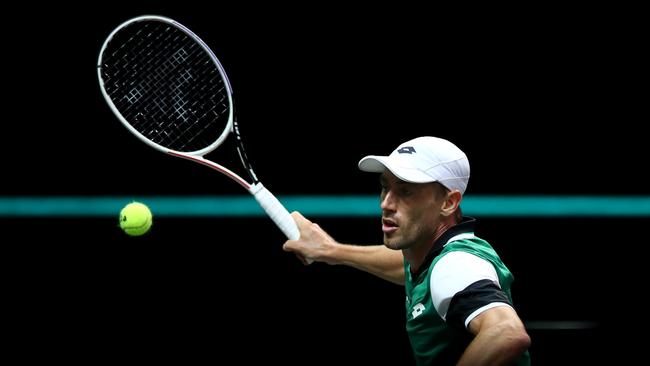
HM: How do stockings, coat hangers and clotheslines come into play for you as a young kid?
JM: That’s purely my mother’s influence! Mum would always set up little challenges to keep all her kids active. One of those was on a Hills hoist. She would put pieces of paper in the stockings, and we’d use coat hangers stuffed inside stockings as racquets to hit them.
HM: Do you remember first picking up a real racquet?
JM: My early memories are of my sisters playing tennis. I would have been about three years old when I first picked one up, but it was only because they were playing and I wanted to beat them!
HM: When do you start feeling like you might be all right?
JM: When I started beating my older sisters! As a kid, you love beating your siblings. I started playing fixtures at four and a half years old, and I remember getting a big trophy from Ken Laffey. Once you have one, I think you go searching for more. One of the hardest things early on was learning how to score, because if you wanted to play fixtures at Laff’s, you had to take your turn umpiring for your team. Learning the points system was hard as a four-year-old!
HM: Before you headed onto the tour, you had to finish school.
JM: Yeah, that was the deal. I was at a high school called Brisbane Grammar School, and a lot of my peers were starting to leave school and play tennis full time. I thought it was the end of the world as I wasn’t getting the same amount of time on court as them. Brisbane Grammar weren’t overly flexible in allowing me to take time off school to play tennis. I was pushing Mum and Dad quite hard to stop school. I was ready to embark on this junior tennis career to try and play the junior slams, the junior Australian Open, junior Wimbledon. Mum and Dad were school teachers, and they were adamant that I finish school. I transferred to Anglican Church Grammar School, and they were far more flexible. I could still do a bit of training, and from then on, the idea was that when I finished year 12, I’d give this tennis thing a bit of a crack. I never knew how hard it was going to be.
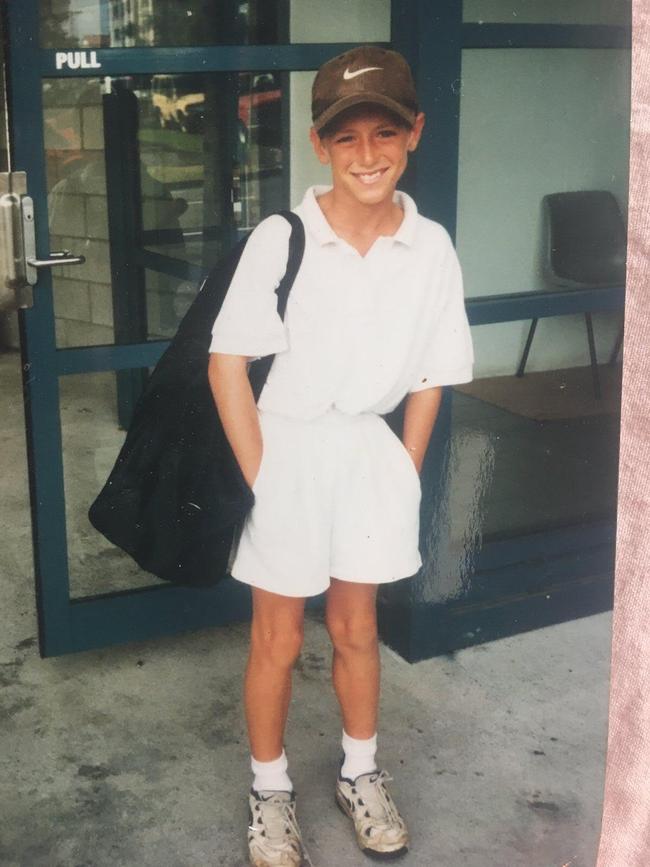
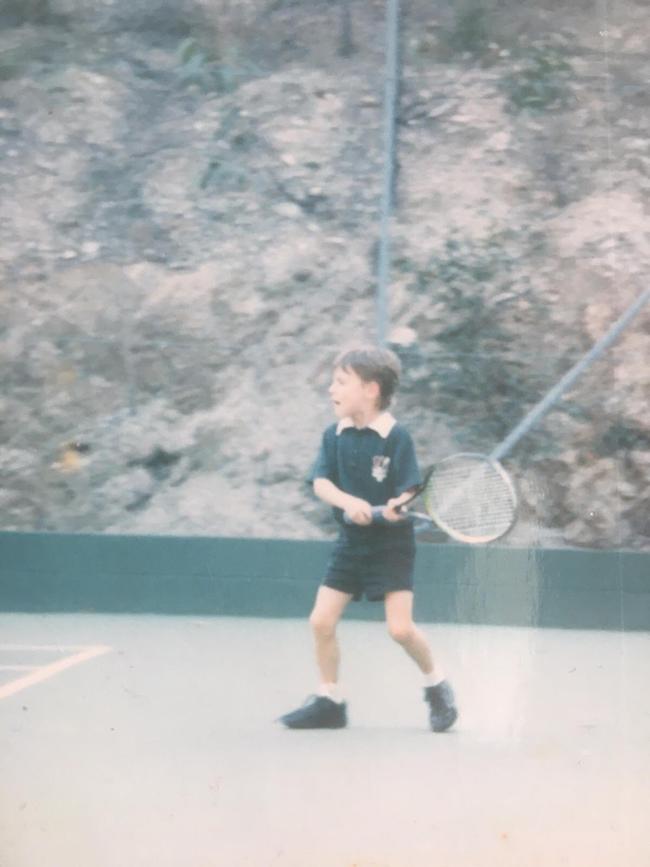
HM: You turn pro in 2006. Suddenly, you go from a competitive player in the juniors in Australia, to what I’ve heard you describe as, “a very, very small fish in a very large ocean”.
JM: That’s exactly right. It’s very daunting. I hadn’t done much travel before that. I played a couple of junior tournaments in New Zealand, New Caledonia and Fiji, but that was the extent of my travels. I hadn’t done the junior slams, and a lot of people in my age group in Australia had. I remember going away for the first time, to America, and it was really challenging. I had my first shoulder surgery straight out of school, and I spent that next year recovering. I went overseas with ‘The Fox’ (Dad) and our first port of call was Spain. That’s when the rude awakening happened. Suddenly I found myself thinking, “Oh boy, this is going to be bloody tough. Those dreams I had are going to take a hell of a lot of work to become reality!” Suddenly you are in Spain, and a part of a 128-player draw who are all simply trying to qualify for the main draw. And they are all just as hungry and talented and driven.
HM: It’s not as easy as it looks!
JM: It’s really bloody hard! You have to win four rounds just to get into the main draw. You’re not getting paid, and you only get €100 if you get into the main draws because it’s the lowest level of a professional tournament on the tour. Even if you make the main draw, you’re probably going to lose a fair bit of money that week trying to improve. Doubt started to creep in pretty quickly.
HM: Doubt and injuries … not a great combination.
JM: Doubt, and two shoulder operations, and one groin operation. The second shoulder was the big one. That was nearly a career ender.
HM: When you had the second shoulder operation and people started to think we have seen the end of you, what year was that?
JM: That was the end of 2013. I’d started to play some really good tennis, and was about 130 in the world. The year before I’d played club tennis in Germany to try and keep my head above the water and earn some money. When you play club tennis, you get a little bit of money …
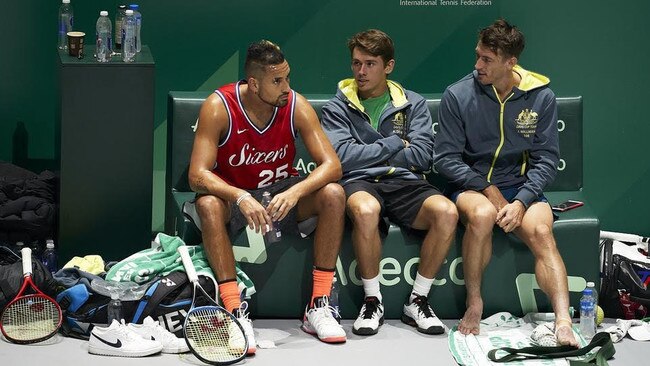
HM: … but no ranking points.
JM: None! If you don’t have that backing from sponsors, you have to find a way to keep your head above the water to try and keep the dream alive. That was club tennis. After getting my ranking down to 130, I had no points for the next three or four months to defend. I was in Munich in the lead-up to the French Open, and I really thought that this was my opportunity: “The next three or four months, I’m going to be playing tournaments, with no points to defend, I’ll have a real shot here to get my ranking up and play in some main draws and a major.” My shoulder started to get really sore, and when I went up for an overhead in a warm-up, I knew I was in trouble. I kept cracking on and was set to be in the main draw of the French Open after I was given a wildcard. They did a scan on the day off, and I had to make the decision. They told me I had a SLAP tear in my shoulder. “We can inject it, and you might be able to play the French Open, but after that you’ll be in a bit of trouble.” I wasn’t comfortable walking onto the court if I wasn’t 100 per cent fit. I rescinded my wildcard. From there it was surgery, and 13 months out of the game, and an uphill battle to get myself back on track.
HM: That was in ’13. You turned pro in 2006. You didn’t win a grand slam match until 2015. Tell me about the loneliness and the doubt through that time. You must be filled with doubt. “Have I made the right decision? Am I going backwards? Is life going to disappear on me? Am I good enough?” It must be an unbelievably difficult mindset to get your head around.
JM: Massively. One of the things that I was very adamant on was that if I was going to play tennis, I didn’t want to rely on my parents’ money to do it. They have four daughters, and they made tremendous sacrifices to get us all through private school. They were working five jobs between them at some stages. You had to get creative. I played club tennis, and I was doing it tough. If you weren’t winning matches, you wouldn’t be sleeping in hotels.
HM: Were you sleeping in train stations, airports?
JM: Yep. That’s what you had to do to get by! If you were really short on cash and you needed to get from A to B, and it just wasn’t viable that night to sleep in a bed, you had to be really sparingly with how you spent your money. This isn’t a sob story …
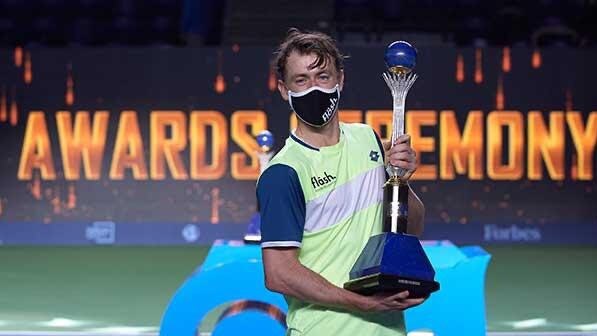
HM: … it’s just reality. Sam Stosur tells the same story.
JM: That is the tennis tour. It’s really top-end-heavy earnings wise, and you have to be smart with how you spend your money. You have to do the little things, and if that means sleeping on the train station floor overnight, you do that. It’s do or die. Eat or be eaten.
HM: Low lows, and high highs. What’s the highest high you’ve had from tennis?
JM: There’s a couple. And both come from playing for your country. For me, they are the most special moments in tennis. We were getting ready to play the semi of a Davis Cup in Belgium, but I’d never been chosen to play. I’d been in and around the squad, but I’d never been given my number. In Davis Cup you get given a number when you represent the country. It’s a competition that’s been around for nearly 120 years. To think that in a 120-year comp I’m the 108th person to ever wear the green and gold, that gives me goosebumps just talking about it! When I was told I was playing it was on a Wednesday morning. We were in Brussels, and we were getting ready to play the Belgians in a really challenging semi-final. Indoor, heavy clay. Lleyton pulled me into the room next door. He said, “Mate, it’s your time to step up and wear the green and gold. We want you to play day one against David Goffin.” It doesn’t get much more challenging than that! I’m not normally lost for words, but in that moment, I was.
HM: A dream. And the other?
JM: It was the opening ceremony of the 2016 Olympics. We were just about to go out, and Argentina started doing their football chants. The whole tunnel leading into the Maracanã (Stadium) was vibrating, and you could see in the distance the bright lights of the opening ceremony. The Argentinians got the place rocking. I would love to say the Australians did too, but the “Aussie, Aussie, Aussie, Oi, Oi, Oi” didn’t actually cut it … that was just unbelievable. How lucky I am to have been able to play Davis Cup and go to the Olympics and represent this great country?
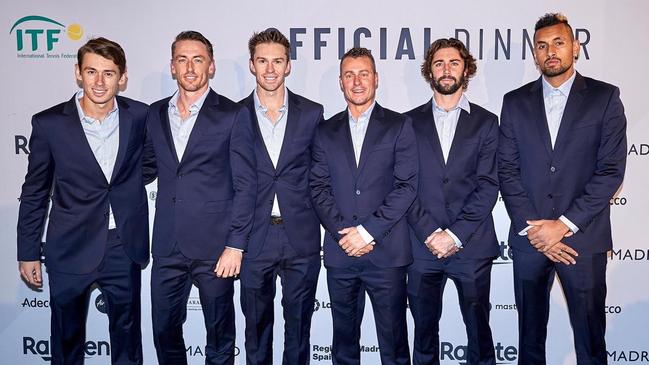
HM: You win your first grand slam match at Wimbledon in 2015. You dreamt about Wimbledon as a kid.
JM: Wimbledon is so special. It is so tough to get into the main draw at Wimbledon. I remember the first time I was playing qualifiers there, in 2010. I rocked up to Wimbledon to practise, and we were there a few days early. We were told pretty quickly, “You’re at the wrong place, and you’re not to come in through the gates. Qualifying is down the road at Roehampton.” Qualifying was actually on some cricket fields! It was a rude awakening. It’s the only tournament where you play qualifying, off site! The ice baths were actually kids’ blow-up pools filled with ice, and the food back then was just one of those makeshift tents that you go and eat in. It wasn’t the Wimbledon I had imagined, but I guess I hadn’t qualified so I didn’t deserve the Wimbledon I had dreamt of yet!
HM: And when you do get to Wimbledon …
JM: When I qualified for Wimbledon for the first time, in 2015, it also coincided with me making the top 100 for the first time in my career. That was a really special achievement for me. Wimbledon is the Augusta of golf, the Lords of cricket. Just one of the most extraordinary places. All of a sudden, you’re not eating in a tent, it’s beautiful food and gardens, even the ice baths are incredible! One of my favourite experiences is on the Saturday before the tournament starts. It’s the one day that the non-seeds get to hit on the match courts. These courts haven’t been hit on for the year leading up to the championships. You get your 45 minutes, and you make sure that’s a really good hit.
HM: Did you have a wardrobe malfunction at Wimbledon?
JM: I did. The Fox came to the rescue! Wimbledon is the tournament that my dad loves the most. They’re very strict, but I never knew how strict. I knew you had to wear all whites. I was called into the referee’s office after one of my matches and was told off. I was wearing the wrong-coloured underwear! Apparently, you could see it beneath, but my old man was more than happy to go and get me a new pair to use the next day.
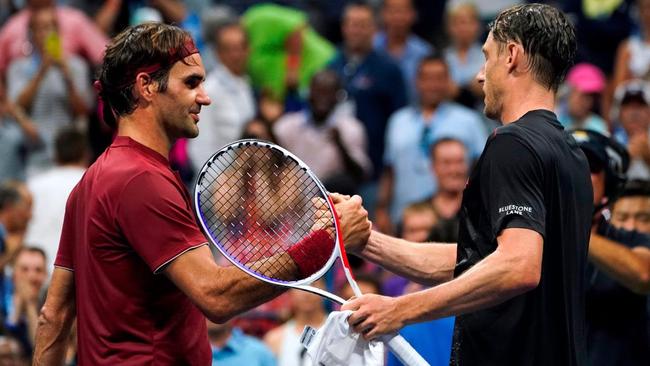
HM: Well played, The Fox. Just speaking of Wimbledon champions, no one’s won the championship more than Roger. How did you first come into contact with the great man?
JM: That was in Brisbane, and it was quite a daunting experience. It’s always more challenging when you’re playing at home in front of a home crowd, and there’s no bigger home crowd for me than the Brisbane International. When I go on court, I really do like to feel as if I am playing for more than just myself. I really want to represent the people who have got me to that position as best as possible. My folks, all the coaches I’ve had, and just the people that have had really significant impacts on my career. When you draw Roger Federer in your home tournament, there is a little bit of anxiety, because you want to go out there and do yourself justice. He’s made many people look silly before, and you just hope you’re not going to be one of those people. It was an awesome experience. I was playing against one of the greatest ever and managed to play some pretty good tennis. I was able to really take it to him. The one thing that Roger is, besides a great tennis player, is he’s really classy. He always gives you a fair bit of time. I’ve been lucky enough that, throughout my career, he and his team have always given me the time of day.
HM: You’ve been asked to train with Federer a bit. Who actually rings you?
JM: It’s normally through Severin Lüthi, Roger’s long-time coach. He’s the Davis Cup coach for Switzerland, and he’s awesome. I was at Roland-Garros and hadn’t had a good campaign there. I get a message from Sevvy saying, “Hey, Johnny, can you get to Switzerland? We’d love you to do a few days on the grass with Roger.” He didn’t have to ask me twice! We were hitting at Jorge Lemann’s house, one of the wealthier guys in the world. I never knew that until we rolled into his house, which is on Lake Zurich. Literally on the lake. It was a soft grass court. I was so super tight the first couple of hits, I was so worried I wouldn’t hit well with Roger, and also concerned that I was going to shank some of these balls into the lake! Do you fetch them yourself?
HM: You spent a few days in Switzerland with Roger. What do you learn?
JM: You try to soak it all in. The whole time you’re trying to be a sponge, you’re trying to see how he operates, what types of shots he hits in certain situations, and what he’s doing off the court. Everyone has their own training style and regimen, and everyone operates a bit differently.
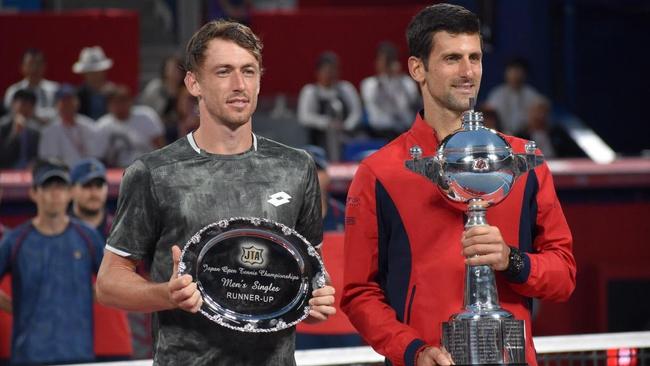
HM: Anything specific?
JM: Ummm … well, my girlfriend is a huge Roger fan like most of us, and she was so curious about what he ate for lunch. I’m not sure why, but I think she had it in her head that these top players were eating Michelin-star food every day. He loved Schweizer Wurstsalat, which is like a sausage salad in Germany. A simple, spammy sausage salad. It took her by surprise, and he got me into it. “Johnny, you’ve got to try the Schweizer wurstsalat here.” He’s one of the biggest figures in the world, he treats people with unbelievable respect, and he’s as much a champion off the court as he is on it.
HM: He is arguably the greatest of all time, and you’ve beaten him in a major!
JM: We always talk about indirect wins in tennis … by beating Roger, I’ve had an indirect win over everyone! It was a good night out for me when I beat him at the US Open. It was everything that I stand for when I walk onto the court. Control what I can control and have that belief in yourself. That’s something that took a long time for me to build, is that belief. The belief that you belong. I’m really glad that I could get a win like that in my career, because I’d been knocking on the door to beat one of the top players, but to do it on the biggest stage just made the whole journey, and all the struggles, worthwhile.
HM: You’ve beaten arguably the greatest of all time, the highest you’ve been is 33, you sit in the top 40 now. Do you now genuinely believe you are one of the best tennis players in the world, or is there still a degree of doubt, that this could end at any minute?
JM: I never feel comfortable. With how the points system works, you have to be on your game the whole time. And I’ve had serious career-threatening injuries, where in one moment it can all be over if you get unlucky. You get shown that you could be back in an office in a suit all too quickly. I never feel all that comfortable. Now I am at the stage where, if that were to happen, I’d be bitterly disappointed, but content that I had given it a real crack. I haven’t quite maximised my potential, but I’m pretty close, and that’s a really satisfying feeling.
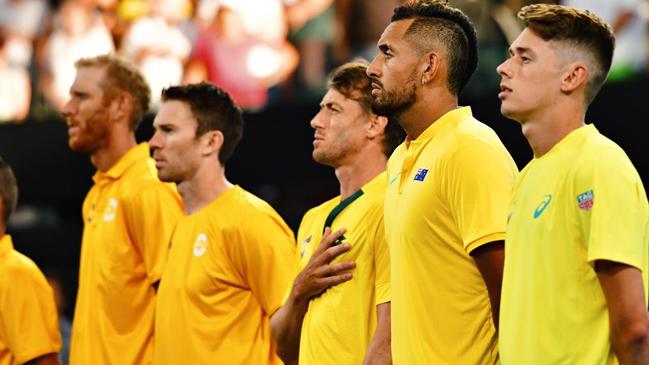
HM: Did I read somewhere that you get off the court and you’re abused for beating Roger?
JM: Any match you play, you get abused, because gambling has become massive in sport. Tennis is one of the most bet-on sports in the world, so when you muck up someone’s multi, they don’t mind telling you about it! You can get some pretty serious ones, and your girlfriend, your family – they get death threats. Some of these players are worshipped back in their parts. If you knock off someone like a Roger, you have some passionate fans who don’t mind abusing you. When you win, it’s easier to take the abuse, but when you lose, that’s when it hurts a bit more.
HM: When you’re playing a major somewhere, and you’re having a bad afternoon, how lonely does it get when you’re two sets to love down, down a break, hitting it as though you’ve never held a racquet before, at a full stadium of fans and television cameras?
JM: Really really challenging. You just want a hole to open up, and you just want to jump in and have it swallow you up so you don’t have to face the music and you can disappear! One thing my parents did teach me is you fight until the end. That’s just a non-negotiable. I still try to give it my all, even if it’s not happening for me that day. Tennis is a lonely sport, and it’s not just lonely when you’re on the court, it’s lonely off it too. You’re in your own thoughts a lot!
HM: You parents talk about how you need to love to compete, but weren’t they big on you being a good person, first and foremost?
JM: They were. They are more disappointed with me if I let myself down, or if I’m not behaving in a way that is the standard that they’ve held me to. It doesn’t happen too often, which I’m very proud of. You go out there, you compete your hardest, you believe in yourself, and at the end of the day you shake the other persons hand and, if they’re too good, you tell them that. It took a while for that to click, because as a young kid, I was a crier. It was the end of the world if I lost!
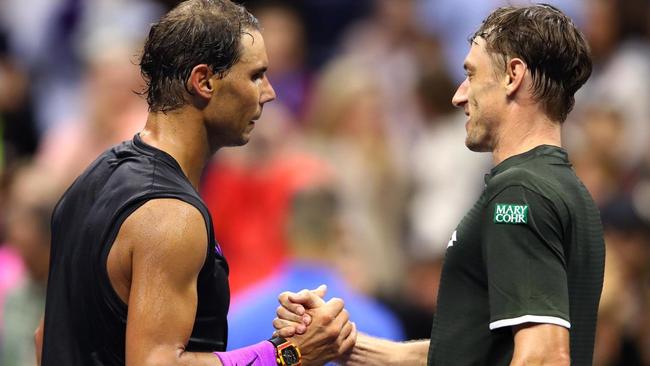
HM: Is it true when you were about eight when Ken Laffey gave you a call?
JM: Ashley Cooper was meant to be the person that was going to deliver me that message, and he didn’t have the stomach for it. I heard that a bit later on. True. Ken Laffey, my coach, was always pretty tough, and he wouldn’t mind me saying that. I was carrying on like an idiot, and Mum was sick to death of it. I had a hard talking to from Ken Laffey, and I even have a report card from one of his training sessions. “Forehand going well, backhand going well, serve needs improvement, attitude – he has to stop crying.” My attitude wasn’t perfect, but it changed after that.
HM: When it’s all done, what are you going to miss most?
JM: The big moments. The feeling you get the day before a slam, walking into the Wimbledon gates, knowing that you’re a competitor. That practice session on Saturday. There are little moments that you miss the most, and when you’re young everything is an experience, but when you are older, week to week, it’s your job and it’s not as exciting as it once was. There are still moments scattered throughout the year that give you goosebumps, and that Saturday hit at Wimbledon for me is one of those moments. Walking on court to a home crowd at an Australian Open. I try to take snapshots of those moments and try to hold on to them.
HM: If you were going to play one final match, and you have The Fox, Mum, your sisters, a full house. What court are you playing on, and who are you playing?
JM: Davis Cup Final. Deciding rubber. Pat Rafter Arena, and I don’t care who it’s against! When that tie is won, to have your team jump the barrier and swamp you, that’s the stuff that dreams are made of.
HM: Loved chatting.
JM: Anytime, mate.




